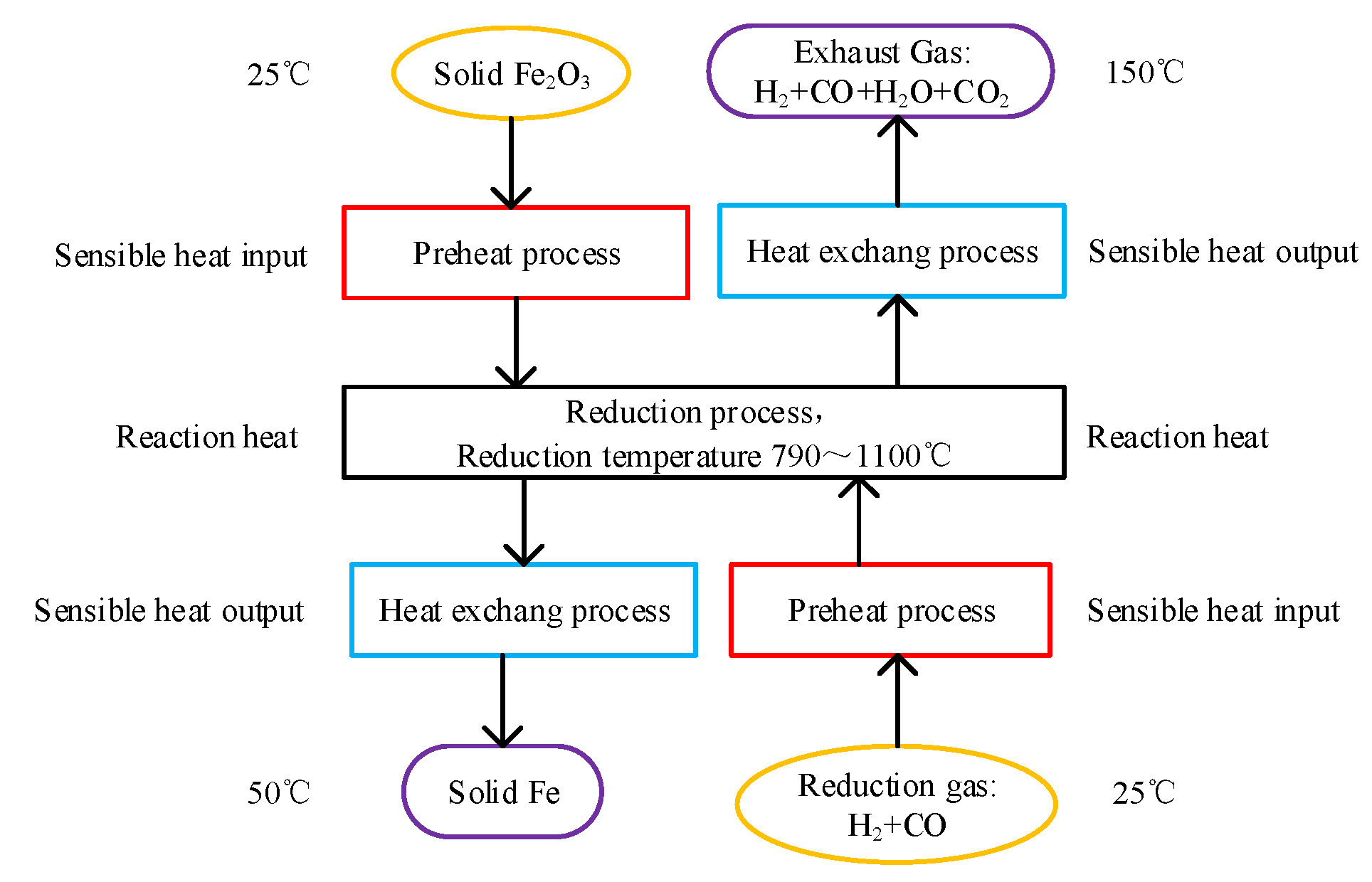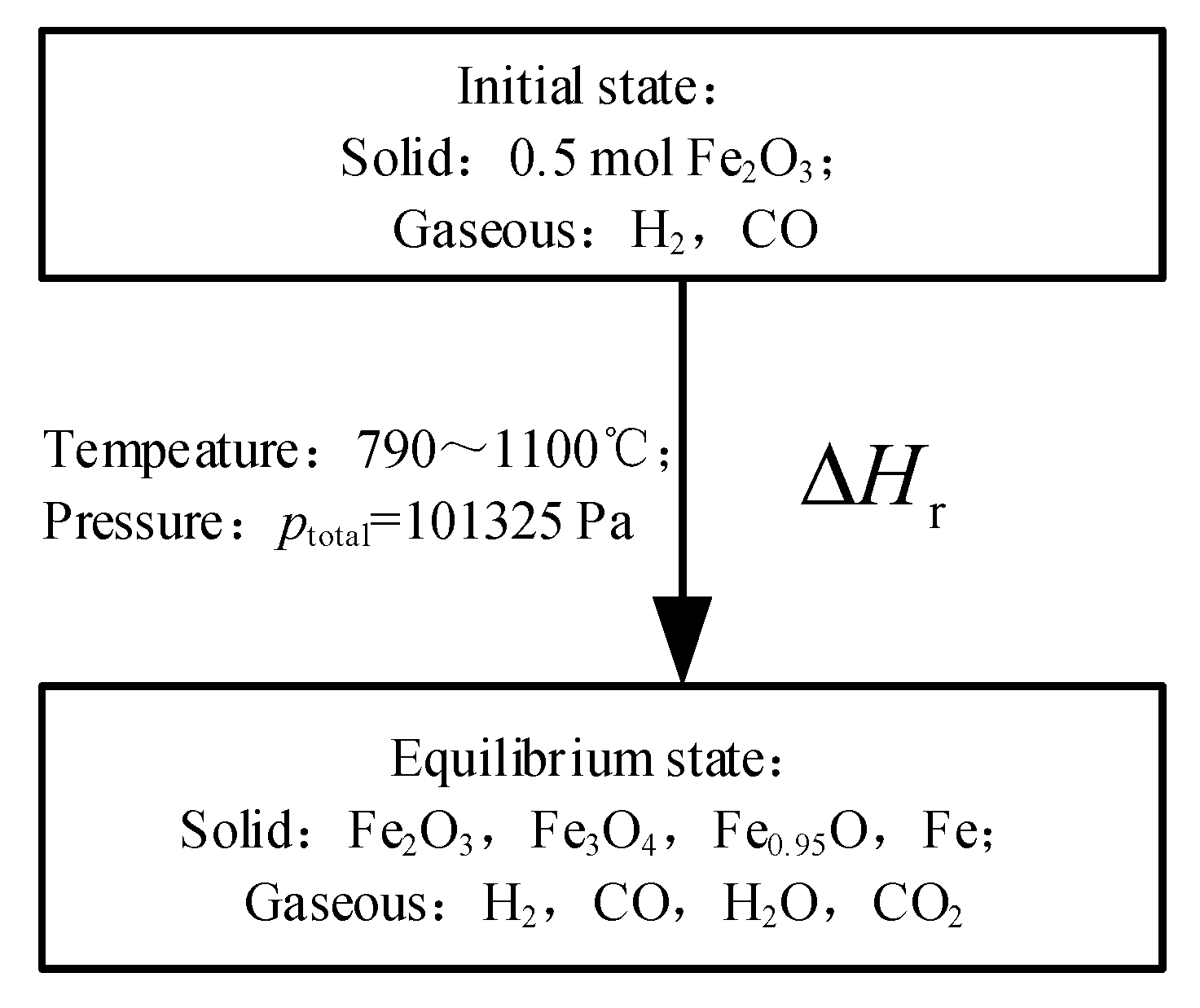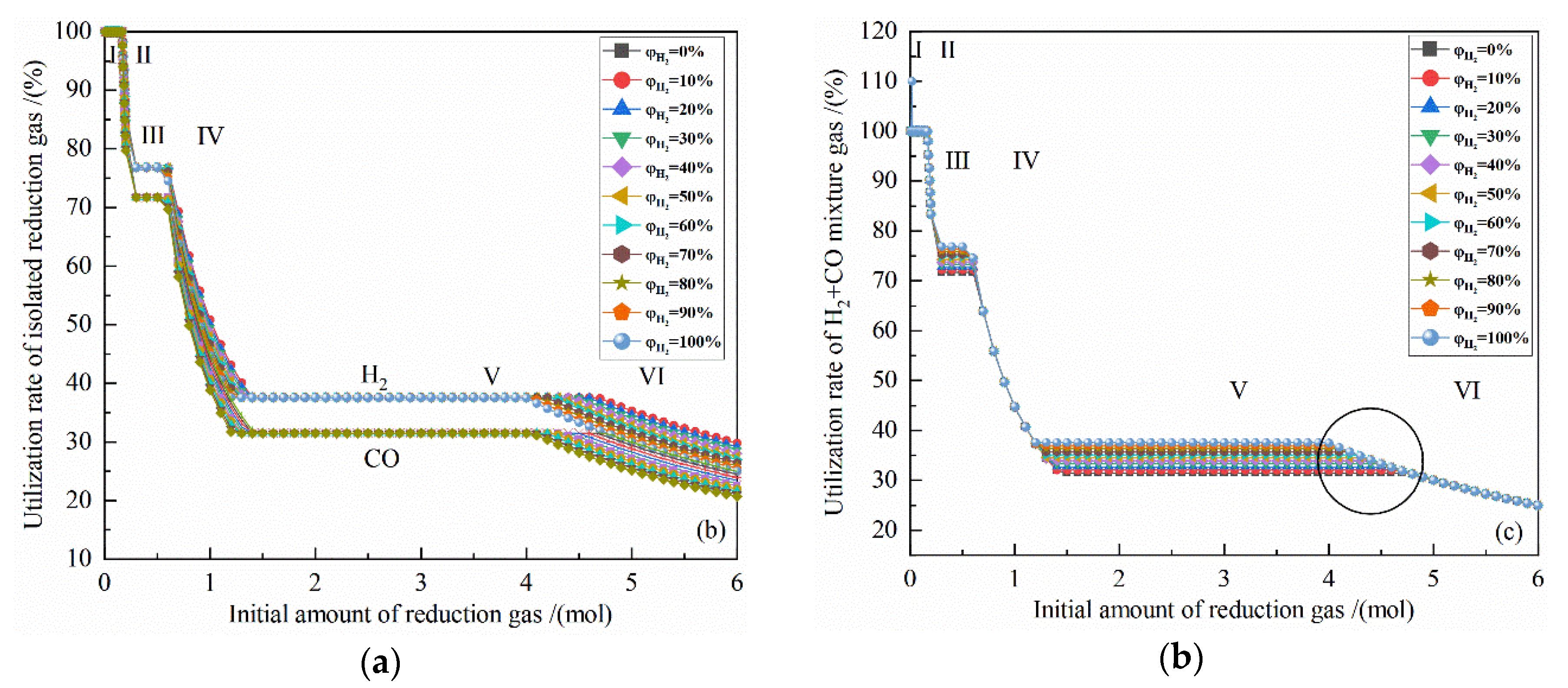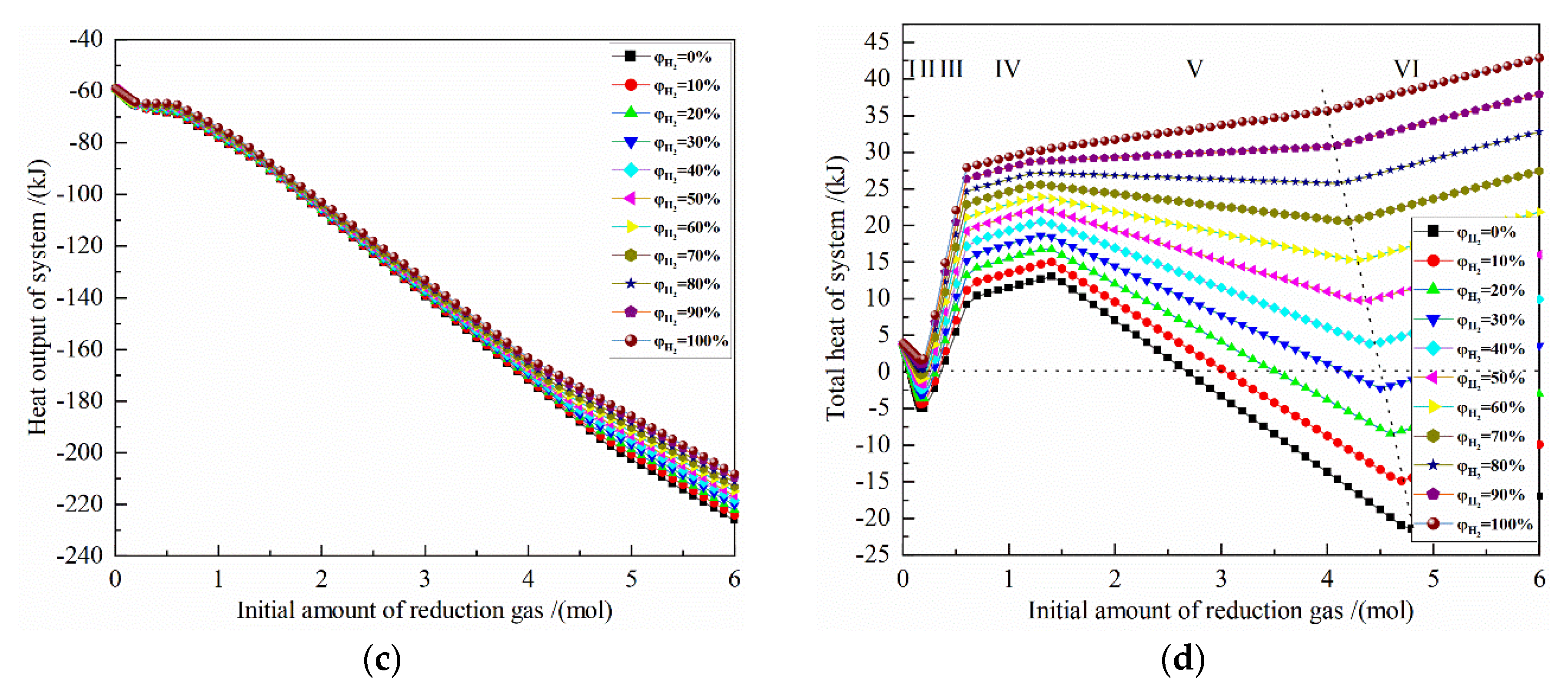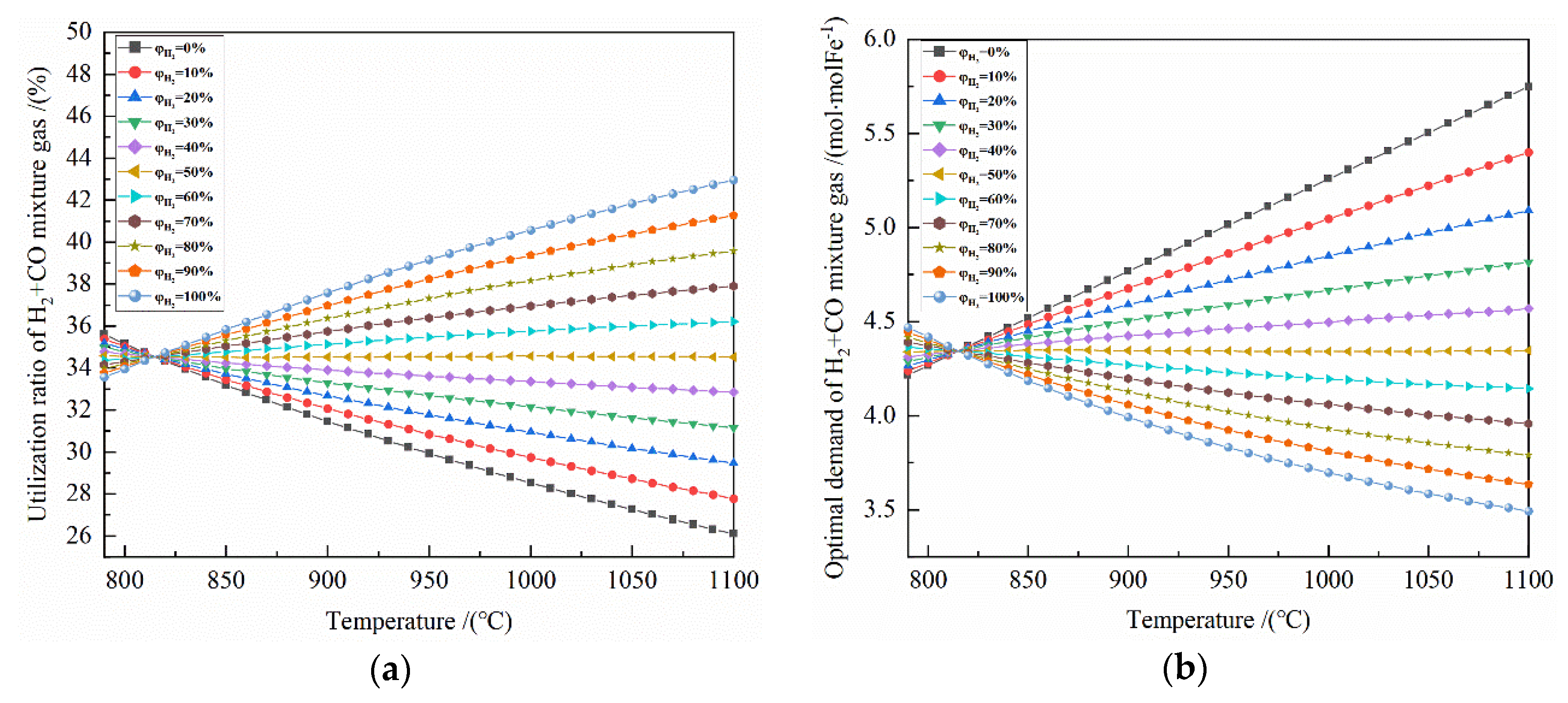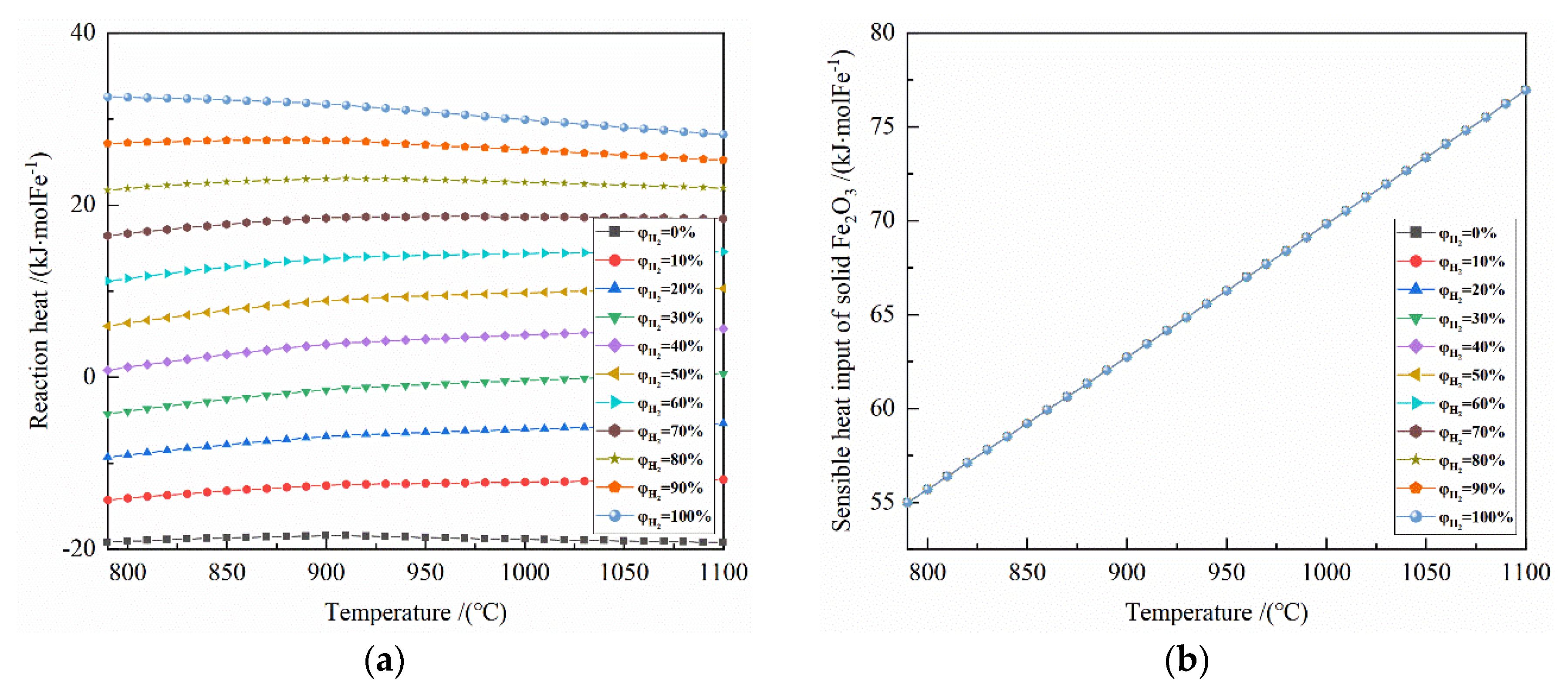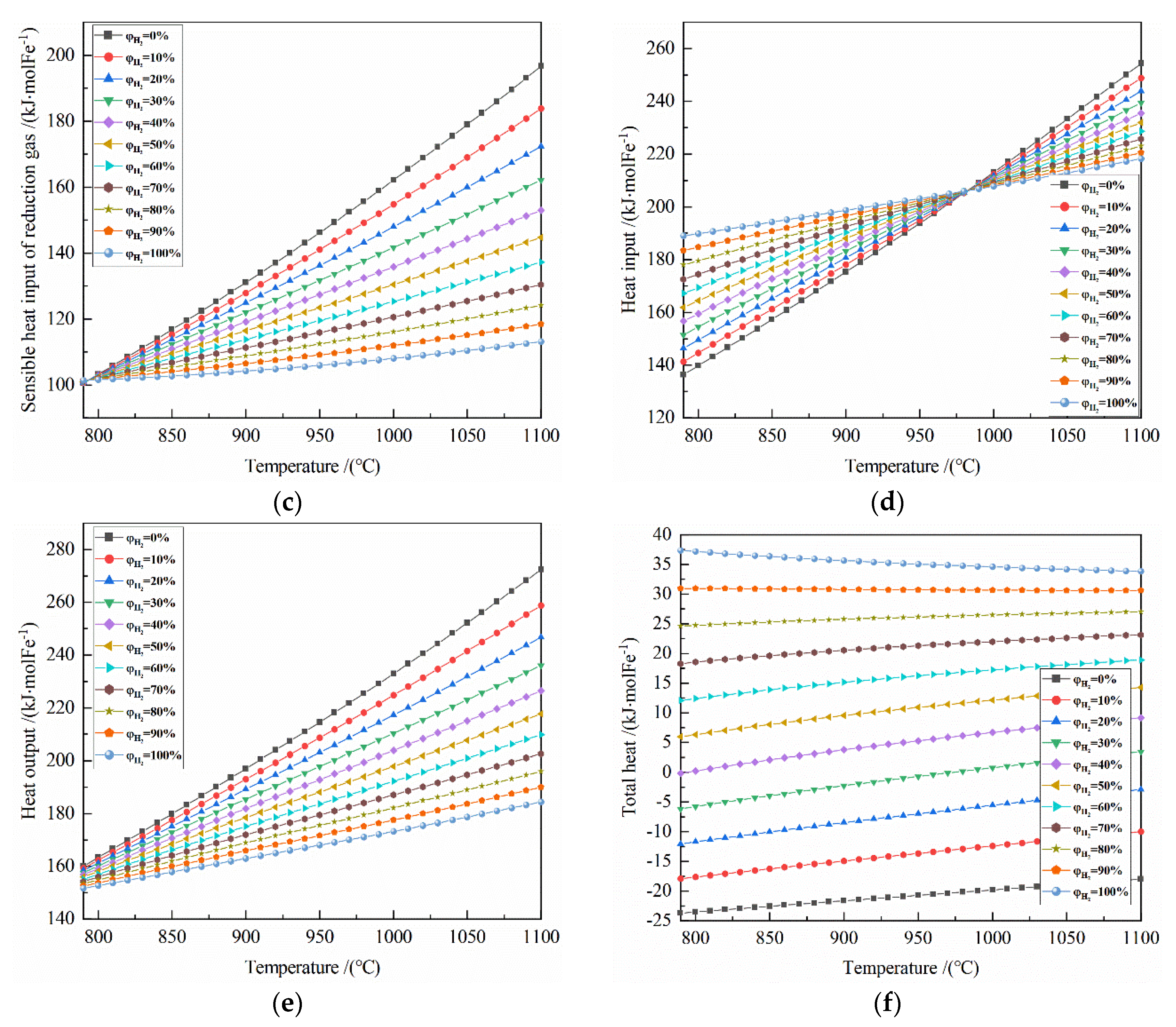The conditions were set as follows: the initial reduction gas amount was 0.005–0.2 mol (increment 0.005 mol), 0.2–6.0 mol (increment 0.1 mol); the reduction temperature was 900 °C; the initial gas was composed of H2 and CO, and the H2 volume fraction was 0–100% (increment 10%); the total pressure was 101,325 Pa; the initial solid was 0.5mol Fe2O3, and the maximum Fe output was 1mol. It should be noted that the reduction reactions and water-gas shift reaction are heterogeneous reactions, as shown in in Formulas (12)–(18), and other carbonization reactions and carbon decomposition reaction are not considered in this study.
3.1.1. Equilibrium Products and Gas Utilization
Figure 3 shows the relationship between the initial amount of reduction gas and the amount of equilibrium products in the reduction of 0.5 mol Fe
2O
3 by 50% H
2 and 50% CO concentration at 900 °C. According to the trend of the product type and the amount of the material, the reduction process can be divided into six stages in sequence.
I, the iron-containing products have Fe2O3 and Fe3O4 at the same time. As the amount of reduction gas increases, Fe2O3 gradually decreases to zero, and Fe3O4 gradually increases to the maximum amount; the chemical reactions can be expressed as Formulas (12) and (13).
II, the iron-containing products only have Fe3O4. As the amount of reduction gas increases, the amount of Fe3O4 remains unchanged.
III, the iron-containing products have Fe3O4 and Fe0.95O at the same time, as the amount of reduction gas increases, Fe3O4 gradually decreases to zero, and Fe0.95O gradually increases to the maximum amount; the chemical reactions can be expressed as Formulas (14) and (15).
IV, the iron-containing products only have Fe0.95O, and as the amount of reduction gas increases, Fe0.95O content remains unchanged.
V, the iron-containing products have Fe0.95O and Fe at the same time, and as the amount of reduction gas increases, Fe0.95O content gradually decreases to zero, and Fe gradually increases to the maximum amount; the chemical reactions can be expressed as Formulas (16) and (17).
VI, iron-containing products only have Fe, as the amount of reduction gas increases, the amount of Fe remains unchanged.
Figure 4a shows the relationship between the gas utilization rate of isolated reduction gas and the initial amount of reduction gas at 900 °C with varied H
2 concentrations. It can be seen from
Figure 4a that at 900 °C, as the amount of reduction gas increases, the gas utilization rate of isolated H
2 and isolated CO are 100% at the I stage. The utilization rates of H
2 and CO at the II stage drop to 76.87% and 71.71%, respectively. The utilization rates of H
2 and CO at the III stage remain unchanged. The utilization rate of H
2 and CO at the IV stage decreases to 37.58% and 31.46%. The gas utilization rate at the V stage remains unchanged, and at the VI stage continues to decline. The increase of the amount of reduction gas in the I, III, and V stages is used for the reduction reaction, so the utilization rate remains unchanged, and the initial H
2 concentration does not affect the utilization rate of H
2 and CO in these three stages. In the II, IV, and VI stages, no reduction reaction occurs, as the initial gas amount increases, the H
2 and CO utilization rates decrease. Meanwhile, the higher the initial H
2 concentration is, the smaller the H
2 utilization rate is, and the greater the CO utilization rate is.
The coincident points can be observed in
Figure 4a at the reduction reaction occurring stages, which means that the initial concertation of H
2 or CO does not affect the utilization rate of isolated gas, namely the water-gas shift reaction does not affect the utilization rate of isolated gas in gas-based direct ironmaking.
It can be seen from
Figure 4b that at the II, IV, and VI stages in which no reduction reaction has occurred and at the I stage in which Fe
2O
3 are reduced to Fe
3O
4, the points of the H
2 + CO mixture utilization rate overlap, indicating that the H
2 concentration and the amount of reduction gas have no effect on H
2 + CO mixture utilization rate of reduction gas in these four stages. In the III and V stage, the 11 lines of the H
2 + CO mixture utilization rate level are displayed in parallel, indicating that the H
2 concentration has a linear effect on the H
2 + CO mixture utilization rate. Since the initial reduction gas is composed of H
2 and CO, namely
, so
It is known from
Figure 4a that the gas utilization rate of isolated reduction gas in the III and V stage is independent of the amount of reduction gas and the reduction gas concentration. From Formula (19), it can be observed that the H
2 + CO mixture utilization rate is proportional to the initial H
2 concentration of the reduction gas. The H
2 + CO mixture utilization rate at 900 °C is positively related to the initial H
2 concentration, as shown in the circle in
Figure 4b.
3.1.2. Energy Consumption
Figure 5 shows the effect of the initial amount of reduction gas on the energy consumption for the reduction of 0.5 mol Fe
2O
3 at 900 °C with varied H
2 concentrations. The X-axis is the increasing reduction gas, and the Y-axis is the energy consumption for the corresponding definition. The horizontal dashed line is 0, ΔH < 0 is exothermic, and ΔH > 0 is endothermic; the oblique dashed line is shown as the energy consumption of the system when 0.5 mol Fe
2O
3 is completely reduced.
It can be seen from
Figure 5a that the change of the reaction heat of the system occurs in the reduction reaction stages I, III and V. According to the calculation principle, the reaction heat of the latter stage includes the reaction heat of all the previous stages, that is, the reaction heat of stage III includes the stages I, II and III, and the reaction heat of stage V includes the stages I, II, III, IV and V. The reaction heat of the I stage is an exothermic reaction, and the larger the initial H
2 concentration is, the smaller the exothermic amount is. At the III stage, as the amount of reduction gas increases, the reaction heat changes from an exothermic reaction to an endothermic reaction for an H
2 concentration of 10% to 100%, and the larger the initial H
2 concentration is, the greater the reaction heat is. In the V stage, for H
2 concentration of 50–100%, the reaction heat gradually increases with the growth of the amount of reduction gas, and the larger the initial H
2 concentration, the greater the reaction heat, and the maximum reaction heat is 31.747 kJ by pure H
2 reduction. For H
2 concentration of 50%, the reaction heat increases very slowly as the amount of reduction gas raises, and the maximum reaction heat is 8.874 kJ. For H
2 concentration of 0% to 40%, the reaction heat increases with the growth of the amount of reduction gas. The increase gradually decreases, and the larger the initial H
2 concentration is, the greater the endothermic energy is. The maximum reaction heat occurs at pure CO reduction and is −18.445 kJ, and the minimum reaction energy occurs at 30% H
2 concentration and is 1.452 kJ.
The sensible heat input of 0.5 mol Fe2O3 from 25 °C to 900 °C is 62.737 kJ. When the amount of reduction gas is 4 mol and 5 mol, the sensible heat inputs of pure CO from 25 °C to 900 °C and from 25 °C to 900 °C are 109.944 kJ and 137.43 kJ, respectively, and the sensible heat inputs of pure H2 gas from 25 °C to 900 °C are 104.384 kJ and 130.480 kJ, respectively.
Figure 5b shows that the larger the amount of reduction gas, the greater the heat input of system. Under the same reduction gas condition, the greater the initial H
2 concentration, the greater the heat input of system. When the amount of reduction gas is greater than 4 mol, the heat input of the reduction system by each H
2 concentration is approximately parallel, because the sensible heat of gas and solid are much larger than the reaction heat of the system. When the amount of reduction gas is 4 mol, the maximum value of heat input is 198.869 kJ with pure H
2 reduction, and the minimum value of heat input is 158.387 kJ with pure CO reduction. When the amount of reduction gas is 5 mol, the maximum value of heat input is 222.355 kJ with pure H
2 reduction, and the minimum value of heat input is 181.722 kJ with pure CO reduction. The difference between the maximum and the minimum values are 40.482 kJ and 40.633 kJ, respectively, which are approximately the same.
It can be seen from
Figure 5c that the more reduction gas there is, the greater the recovery heat output will be. Under the same reduction gas amount condition, the larger the initial H
2 concentration is, the smaller the system recoverable heat is. When the amount of reduction gas is 4 mol, the maximum absolute value of heat output is −172.066 kJ with pure CO reduction, and the minimum absolute value of heat output is −163.189 kJ with pure H
2 reduction. When the amount of reduction gas is 5 mol, the maximum absolute value of heat output is −202.503 kJ with pure CO reduction, and the minimum absolute value of heat output is −185.678 kJ with pure H
2 reduction. The difference between the maximum and the minimum values are −8.877 kJ and 16.825 kJ, respectively.
From
Figure 5d, it can be seen that for the H
2 concentration of 40–100%, the total heat of the system increases as the initial H
2 concentration increases. For the H
2 concentration of 0–30%, the smaller the initial H
2 concentration is, the larger the system total heat is. For the H
2 concentrations of 30% and 40%, the optimal amount of reduction gas is 4.4 mol and 4.5 mol, respectively, and the system total heat is −1.545 kJ and 4.056 kJ, respectively. If the linear difference method is used, when the system total heat is 0, the H
2 concentration is about 32.8%. In addition, after metalized Fe is fully obtained, increasing the amount of reduction gas will greatly increase the total energy consumption, which is not worthwhile. At 900 °C, 0.5 mol Fe
2O
3 is reduced to 1 mol Fe. The system total heat is 35.680 kJ for pure H
2 reduction and −21.527 kJ for pure CO reduction. For other initial concentrations, the system total heat is in between.
